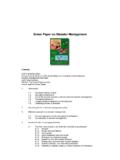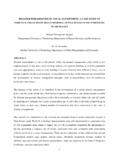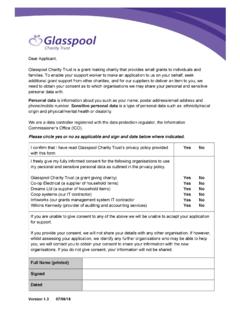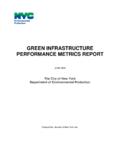Transcription of Data availability and requirements for flood hazard ...
1 data availability and requirements for flood hazard mapping in South Africa Author: Zelda Els Co-authors: Dr A van Niekerk & Prof DM Sakulski Research aim your knowledge partner The aim of this study is to evaluate if the existing data in South Africa is adequate for flood hazard mapping or if additional data are required. Problem statement floods have been identified as one of the major natural hazards in both the world (Klijn 2009), and South Africa (Halloway et al. 2010). your knowledge partner Source: EM-DAT (2010). Figure Number of natural disasters reported 1900 2009. Problem statement The Acts: your knowledge partner The Disaster Management Act of South Africa, stipulates that measures to prevent and reduce disaster risks and to mitigate the severity of a disaster, must take place at all three levels of government, namely national, provincial and municipal (Act No.)
2 57 of 2002). National Water Act sections 121 and 144: flood hazard mapping is only required for dams or categories of dams with a safety risk and for new developments on town layout plans where the 100-year floodline needs to be indicated. Problem statement Risk assessment your knowledge partner The first stage, the hazard assessment, is to define the hazard in terms of its frequency, magnitude, speed, onset, affected area and duration. Risk = hazard x Vulnerability Manageability Problem statement your knowledge partner flood hazard mapping in the rural areas are limited to historical maps of floods where available. These historical maps frequently consist of maps from the 1:250 000 topographic map series on which the extent of a flood is indicated with pencil by the relevant DWA. Officer for the region.
3 Why? Acts data availability Research objectives your knowledge partner Review the literature on disaster risk management, floods , flood hazard mapping, and different types of existing flood modelling methodologies. Determine the minimum data requirements for flood modelling and carry out an assessment of available data in South Africa. Perform and evaluate the suggested methodology for flood modelling with the available data . Evaluate the flood mapping results to identify any limitations and propose recommendations should alternative data sources be required for flood modelling in South Africa. flood hazard mapping your knowledge partner The purpose of flood hazard mapping (Martini & Loat 2007): Frequency-the probability of an occurrence in a specific time period;. extent-the geographical area of impact.
4 Severity (intensity)-the water level or water depths; and flow velocity and/or direction of flow. flood hazard mapping your knowledge partner Basic types: historical (event) map indicates the locations of historical events with point symbols on a map (see Figure A);. extent map: is the most common and displays the inundated areas of a flood event that can either be historical or hypothetical (see Figure B);. flood depth : displays the water depths (levels) derived from one- and two dimensional models for river flooding (see Figure C);. flow velocity: indicates the velocity of the water flow and are determined with two dimensional models. One dimensional models can also be used but it is more complex;. flood wave: displays the movement of the wave and are determined by two dimensional models; and duration of inundation: the period that an area is under water.
5 flood hazard mapping requirements and scale your knowledge partner flood PARAMETER. REQUIREMENT SCALE/LEVEL (BOLD indicates minimal parameters to be mapped). National/regional 1:100 000-1:1 000 000 Extent Disaster management planning Extent, depth and other Local 1:5 000-1:50 000. parameters if appropriate National/regional 1:100 000-1:500 000 Extent Town planning (Land use) Extent for different Local 1:5 000-1:25 000 probabilities, depth, velocity and duration National/regional 1:100 000-1:500 000 Extent Emergency planning and management Extent and depth for different Local 1:5 000-1:25 000 return periods, and other parameters if appropriate Extent for different Public awareness Local 1:10 000-1:25 000. probabilities and depth Extent for different Insurance Local 1:10 000-1:25 000 probabilities, depth, and velocity (if significant).
6 Adapted from: Martini & Loat (2007: 13-16). flood hazard mapping requirements and scale your knowledge partner In South Africa, the National Water Act (sections 121 and 144), only requires the 100 year flood line for new developments on town layout plans (South Africa 1998). No further guidelines are available for the mapping of probability or scale of a flood hazard in either rural or urban areas. flood hazard mapping flood modelling software your knowledge partner Dimension Distinguishing Features Available Software Potential Application 0D No physical laws included ArcGIS, Delta Broad scale assessment of flood extents and in simulation Mapper,etc. flood depths 1D Solution of one- Infoworks RS (ISIS), Design scale modelling which can be of the dimensional St. Venant Mike 11, HEC-RAS order of 10-100 s of km depending on catchment equations size 1D+ 1D plus flood storage cell Inforworks RS Design scale modelling which can be of the approach to the simulation (ISIS), Mike 11, order of 10-100 s of km depending on catchment of floodplain flow HEC-RAS size, also has the potential for broad scale application if used with sparse cross-section data 2D- 2D minus the law of LISFLOOD-FP Broad scale modelling or urban inundation conservation of depending on cell dimensions momentum for the floodplain flow 2D Solution of the two- TUFLOW, Mike 21, Design scale modelling of the order of 10 s km.
7 Dimensional shallow wave TELEMAC May have the potential for use broad scale equation modelling if applied with very course grids 2D+ 2D plus a solution for TELEMAC 3D Predominately coastal modelling applications vertical velocities using where 3D velocity profiles are important. Has continuity only also been applied to reach scale river modelling problems in research projects. 3D Solution of the three- CFX, FLUENT, Local prediction of three-dimensional velocity dimensional Reynolds PHEONIX fields in main channels and floodplains averaged Navior Stokes equations Source: Pender & N elz (2007: 108). Minimum data requirements To model basic flood parameters (extent your knowledge partner and depth): Topographical data that describes the topography of the study area;. Land cover (land use) data to calculate Manning's roughness coefficient.
8 Historical data hydrological data input and for the calibration and validation of the flood modelling. Topographic data Topographic data is required to describe your knowledge partner the river and its surrounding area. DTMs are the most frequently used data source for topographic data . (a) (b) Source: Zeiler (1999: 163). data structures: (a) DEM and (b) TIN. Topographic data your knowledge partner Type data Set Resolution/ Coverage Source Scale Contour CD: NGI 1: 10 000 5m South Africa (SA) CD: NGI (2010a). contours (partial coverage). CD: NGI 1: 50 000 20 m SA CD: NGI (2010a). contours DEM CD: NGI 25m DEM 25 m SA (partial coverage) CD: NGI (2011a). ASTER GDEM 30 m Near-global ERSDAC (2009). CD: NGI 50m DEM 50 m SA (partial coverage) CD: NGI (2011a). SRTM 90m DEM 90 m Near -global ERSDAC (2009).
9 GTOPO30 1 km Global ERSDAC (2009). Topographic data your knowledge partner Martini & Loat (2007) recommends a metre vertical resolution and a 10x10. metres (possibly even 5x5 metres). horizontal resolution as minimum requirements for a DEM. Where contours are used to generate a DEM, the contour should at least be at 1 metre vertical intervals. Topographic data Low resolution (>10 m) DEMs are insufficient for hydraulic modelling of river channels as it cannot your knowledge partner represent sharp topography changes in the terrain. DEMs are sufficient for extracting watershed characteristics in hydrologic analysis and TINs for stream channel description in hydraulic analysis. Although a TIN can be created from a DEM, the stream channel detail is still not sufficient for hydraulic analysis.
10 Generally TINs are recommended as they can potentially provide a better representation of the river channel and surrounding area Topographic data your knowledge partner Type data Set Resolution/ Coverage Source Scale Contour CD: NGI 1: 10 000 5m South Africa (SA) CD: NGI (2010a). contours (partial coverage). CD: NGI 1: 50 000 20 m SA CD: NGI (2010a). contours DEM CD: NGI 25m DEM 25 m SA (partial coverage) CD: NGI (2011a). ASTER GDEM 30 m Global ERSDAC (2009). CD: NGI 50m DEM 50 m SA (partial coverage) CD: NGI (2011a). SRTM 90m DEM 90 m Global ERSDAC (2009). GTOPO30 1 km Global ERSDAC (2009). Land cover (land use) data Land Cover and land use (Thompson 1996). your knowledge partner Land use refers to the human activity ( grazing, conservation) associated with a specific land unit. Land cover refers to all natural features ( vegetation (natural or planted), water, ice, bare rock) and man-made features ( buildings, roads) on the surface of the earth.







